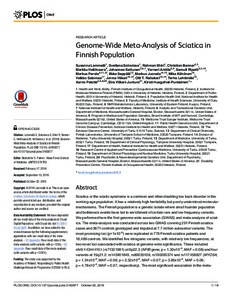Genome-Wide Meta-Analysis of Sciatica in Finnish Population
Lemmela S; Solovieva S; Shiri R; Benner C; Heliovaara M; Kettunen J; Anttila V; Ripatti S; Perola M; Seppala I; Juonala M; Kahonen M; Salomaa V; Viikari J; Raitakari OT; Lehtimaki T; Palotie A; Viikari-Juntura E; Husgafvel-Pursiainen K
Genome-Wide Meta-Analysis of Sciatica in Finnish Population
Lemmela S
Solovieva S
Shiri R
Benner C
Heliovaara M
Kettunen J
Anttila V
Ripatti S
Perola M
Seppala I
Juonala M
Kahonen M
Salomaa V
Viikari J
Raitakari OT
Lehtimaki T
Palotie A
Viikari-Juntura E
Husgafvel-Pursiainen K
PUBLIC LIBRARY SCIENCE
Julkaisun pysyvä osoite on:
https://urn.fi/URN:NBN:fi-fe2021042715791
https://urn.fi/URN:NBN:fi-fe2021042715791
Tiivistelmä
Sciatica or the sciatic syndrome is a common and often disabling low back disorder in the working-age population. It has a relatively high heritability but poorly understood molecular mechanisms. The Finnish population is a genetic isolate where small founder population and bottleneck events have led to enrichment of certain rare and low frequency variants. We performed here the first genome-wide association (GWAS) and meta-analysis of sciatica. The meta-analysis was conducted across two GWAS covering 291 Finnish sciatica cases and 3671 controls genotyped and imputed at 7.7 million autosomal variants. The most promising loci (p<1x10(-6)) were replicated in 776 Finnish sciatica patients and 18,489 controls. We identified five intragenic variants, with relatively low frequencies, at two novel loci associated with sciatica at genome-wide significance. These included chr9:14344410:1 (rs71321981) at 9p22.3 (NFIB gene; p = 1.30x10(-8), MAF = 0.08) and four variants at 15q21.2: rs145901849, rs80035109, rs190200374 and rs117458827 (MYO5A; p = 1.34x10(-8), MAF = 0.06; p = 2.32x10(-8), MAF = 0.07; p = 3.85x10(-8), MAF = 0.06; p = 4.78x10(-8), MAF = 0.07, respectively). The most significant association in the meta-analysis, a single base insertion rs71321981 within the regulatory region of the transcription factor NFIB, replicated in an independent Finnish population sample (p = 0.04). Despite identifying 15q21.2 as a promising locus, we were not able to replicate it. It was differentiated; the lead variants within 15q21.2 were more frequent in Finland (6-7%) than in other European populations (1-2%). Imputation accuracies of the three significantly associated variants (chr9:14344410:1, rs190200374, and rs80035109) were validated by genotyping. In summary, our results suggest a novel locus, 9p22.3 (NFIB), which may be involved in susceptibility to sciatica. In addition, another locus, 15q21.2, emerged as a promising one, but failed to replicate.
Kokoelmat
- Rinnakkaistallenteet [27094]
